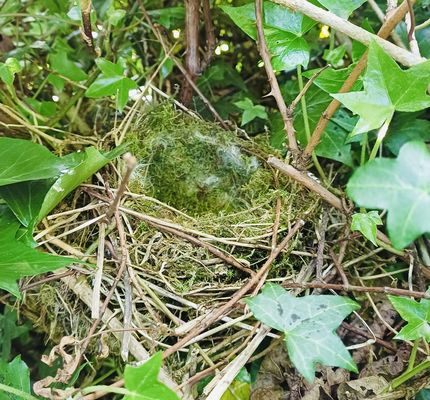EVERY morning Dúlra danders around the outside of the house to scatter some seeds for the birds. The dunnock especially keeps an eye out – as soon as Dúlra steps back indoors, this shy bird quietly emerges from the hedges to gobble up some of the energy-rich food.
For Dúlra, it’s a nice, reassuring routine, a daily chance to observe the ever-changing birdlife in the garden as we head into full-blown spring.
But yesterday he was stopped in his tracks by a horrible sight. Right below the living-room window lay this pitiful bird. It was a young song thrush, frozen in death and lying on the path like a cruel piece of abstract art.
It must have crashed off the pane of glass and died instantly. If you look closely at its beak, you can see the ‘gape’ at the side that signifies a nestling. This bird will have spent about two weeks in the nest with its four or five siblings before emerging into the world, maybe on the very day of its death.
No other bird has ever hit the living-room window to Dúlra’s knowledge, unlike the kitchen window where the feeders are. It was being struck that often that he now has stickers on it. Most of the birds that crashed into it were stunned and able to fly off again after a few minutes – but the stickers mean they totally avoid it now.
It’s a tragedy that any bird dies like this – it’s estimated every home’s windows on average accounts for the death of between one and ten birds a year. That’s between three million and 30 million birds killed by windows every year in Ireland alone.
When Dúlra saw the contorted corpse of the song thrush, he could have cried.
It’s been quite a while since a smólach visited the garden – these birds have gone into serious decline because of the use of slug pellets by gardeners – slugs are their favourite food and, boy, there sure are plenty of them in Dúlra’s garden.
Years ago, Dúlra used to come across the song thrush’s mud-lined nest all the time – they were as common as blackbirds – but although not globally threatened, they are much rarer today. As well as those slug pellets, the chopping down of our hedgerows has taken a toll. But Belfast’s parks still have many pairs and an adult pair can raise a dozen youngsters a year.
This young thrush must have been full of the joys of spring, discovering lush new territory when its life was brought to an abrupt end by an invisible wall. Dúlra can only hope it was a one-off freak accident and the bird’s siblings will enjoy the rich pickings of this pesticide-free garden.
Dúlra enjoyed a dander around the old Sirocco Works land near Short Strand this week. It’s amazing to think that this was once a massive factory where air conditioners were invented and manufactured.
The factory was demolished 15 years ago, leaving 16 acres of grassland. A beautiful red-brick chimney is all that remains of one of Belfast’s largest employers, named after the hot Sirocco wind that blows across the Sahara desert.
The winds of change have certainly been felt here – it’s set to be the site of 675 new homes as part of a £450m waterfront development – but in the meantime, it’s home to wildlife. Not a lot, it must be said – nature has learned to be wary of inner-city green areas. This might look like the perfect breeding ground for lapwing or snipe, but none were there. The only grass-breeding birds were three pairs of meadow pipits, a bird normally associated with our hilltops.
There was one other bird that Dúlra was surprised to see here. Anyone living nearby might be lucky to hear the famous song of the linnet. A single pair have made their home in some whin bushes that have sprung up here. Dúlra didn’t bother trying to find it – he couldn’t face the punishment that whin bushes inevitable dish out – it’s enough to know that such a beautiful finch is breeding in downtown Belfast.
* If you’ve seen or photographed anything interesting, or have any nature questions, you can text Dúlra on 07801 414804.









